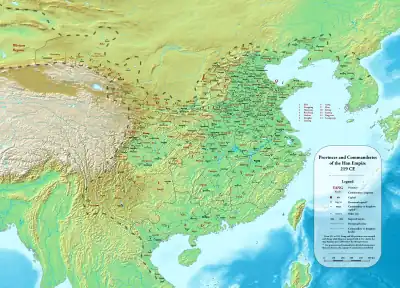.png.webp)
Han dynasty (60 BC)
This is a timeline of the Han dynasty (206 BC–220 AD).
3rd century BC
| Year | Date | Event |
|---|---|---|
| 202 BC | 28 February | Liu Bang becomes emperor of the Han dynasty (posthumously known as Emperor Gaozu of Han)[1] |
| Emperor Gaozu of Han moves the capital from Luoyang to Chang'an[2] | ||
| 201 BC | Battle of Baideng: Emperor Gaozu of Han's army is defeated by the Xiongnu[3] | |
| Xin, King of Han defects to the Xiongnu[3] |
2nd century BC
200s BC
| Year | Date | Event |
|---|---|---|
| 197 BC | The Xiongnu invade Dai Commandery with the help of Chen Xi and Han Xin[4] | |
| 196 BC | Emperor Gaozu of Han replaces nine of the ten Kings of the Han dynasty with his brothers and sons[5] | |
| The Xiongnu invade Dai Commandery with the help of Han Xin[4] | ||
| 195 BC | 1 June | Emperor Gaozu of Han dies and is succeeded by Liu Ying (posthumously Emperor Hui of Han)[6] |
| The Xiongnu invade You Province with the help of Lu Wan[5] |
190s BC
| Year | Date | Event |
|---|---|---|
| 188 BC | Emperor Hui of Han dies and is succeeded by Liu Gong (posthumously Emperor Qianshao of Han)[7] | |
| 184 BC | Emperor Qianshao of Han dies and is succeeded by Liu Hong (posthumously Emperor Houshao of Han) | |
| 182 BC | The Xiongnu invade Longxi Commandery and Tianshui[8] | |
| 181 BC | Nanyue invades Changsha[8] | |
| The Xiongnu invade Longxi Commandery[4] |
180s BC
| Year | Date | Event |
|---|---|---|
| 180 BC | Lü Clan Disturbance: Empress Lü dies and her clan is slaughtered[8] | |
| Emperor Houshao of Han is deposed and succeeded by Liu Heng (posthumously Emperor Wen of Han)[9] | ||
| 179 BC | Earliest archaeological evidence of paper[10] | |
| The Xiongnu invade Yunzhong Commandery[4] | ||
| 177 BC | The Xiongnu invade Ordos[11] | |
| 176 BC | The kingdoms of Liang, Zhao, Qi, Dai, and Huainan are split up[12] |
170s BC
| Year | Date | Event |
|---|---|---|
| 169 BC | The Xiongnu raid Han[4] | |
| 166 BC | A 140,000 strong Xiongnu force invade near Chang'an[13] |
160s BC
| Year | Date | Event |
|---|---|---|
| 160 BC | A system of beacon and lookout stations is deployed[13] | |
| 158 BC | A 30,000 strong Xiongnu force attacks Yunzhong Commandery and Dai Commandery[4] | |
| 157 BC | Emperor Wen of Han dies and is succeeded by Liu Qi (posthumously Emperor Jing of Han)[14] | |
| 154 BC | Rebellion of the Seven States: Liu Pi and six other kings rebel but are defeated[15] |
150s BC
| Year | Date | Event |
|---|---|---|
| 148 BC | The Xiongnu attack Yan Province[4] | |
| 144 BC | The Xiongnu raid Yanmen Pass for horses[4] | |
| 142 BC | The Xiongnu attack Yanmen Pass[4] | |
| 141 BC | Emperor Wen of Han dies and is succeeded by Liu Che (posthumously Emperor Wu of Han)[16] |
140s BC
| Year | Date | Event |
|---|---|---|
| 139 BC | Zhang Qian sets off for the Western Regions[17] | |
| 136 BC | Official posts are created for academicians[18] | |
| 135 BC | Han campaigns against Minyue: A puppet king is installed in Minyue[19] | |
| 133 BC | June | Battle of Mayi: The Han army fails to ambush the Xiongnu[17] |
| 132 BC | Yellow River dikes burst[20] |
130s BC
| Year | Date | Event |
|---|---|---|
| 129 BC | Han forces (40,000) under Wei Qing, Gongsun Ao, Gongsun He, and Li Guang engage in combat with the Xiongnu[21] | |
| 128 BC | The Xiongnu attack Liaoxi and engage in combat with Han forces (40,000) under Wei Qing and Li Xi[22] | |
| Nan Lü of Dongye surrenders to Han and the Canghai Commandery is created[22] | ||
| 127 BC | The Xiongnu raid Liaoxi and Yanmen | |
| Han forces under Wei Qing, Hao Xian, and Li Xi plunder the Xiongnu for livestock[21] | ||
| 126 BC | The Canghai Commandery is abandoned[22] | |
| The Xiongnu army (900,000) raids Han territory | ||
| 124 BC | Han forces (100,000) under Wei Qing attack the Xiongnu[21] | |
| 123 BC | Han forces (100,000) under Wei Qing attack the Xiongnu[21] | |
| 122 BC | The Prince of Huainan rebels and is defeated[23] | |
| The Xiongnu raid Shanggu | ||
| 121 BC | Han forces under Huo Qubing, Zhao Ponu, Zhang Qian, and Li Guang attack the Xiongnu[21] |
120s BC
| Year | Date | Event |
|---|---|---|
| 120 BC | The Xiongnu raid Youbeiping and Xingxiang, taking 1,000 captives | |
| 119 BC | June | Battle of Mobei: Han generals Huo Qubing and Wei Qing defeat the Xiongnu[17] |
| Introduction of the iron and salt monopoly[11] | ||
| New taxes are levied on market transactions, vehicles, and property[24] | ||
| Zhang Qian goes on another trip to the Western Regions[17] | ||
| 116 BC | The Xiongnu raid Liang Province | |
| 113 BC | Reign names are introduced[25] | |
| 112 BC | State monopoly on minting is enacted[26] | |
| A Han force of 20,000 attack the Qing in eastern Tibet | ||
| 111 BC | Han conquest of Nanyue: Han annexes Nanyue[27] | |
| Han campaigns against Minyue: Âu Việt is defeated but the Han evacuate the Yue area rather than annex it; with the exception of Dongye at the mouth of the Min River, modern Fujian would not see significant colonization until 200 AD[28] | ||
| Han forces (25,000)) under Gongsun He and Zhao Ponu try to attack the Xiongnu but can't find them[21] | ||
| Modern Guizhou is incorporated into the empire[29] |
110s BC
| Year | Date | Event |
|---|---|---|
| 110 BC | Emperor Wu of Han personally leads Han forces (180,000) against the Xiongnu but their chanyu decides to retreat[21] | |
| Han secures a marriage alliance with the Wusun through Liu Jieyou[30] | ||
| 109 BC | Han conquest of Dian: The Dian Kingdom becomes a Han vassal[31] | |
| 108 BC | Han conquest of Gojoseon: Han annexes Gojoseon[32] and sets up the Lelang, Lintun, Xuantu, and Zhenfan commanderies[33] | |
| Battle of Loulan: Han subjugates Qiemo and the Jushi Kingdom[34] | ||
| 106 BC | Thirteen regional inspectors are appointed to be directly answerable to the central government[35] | |
| 105 BC | Cai Lun improves on paper using a combination of rags and plant fibers[36] | |
| Aboriginals rebel in the southwest[29] | ||
| 104 BC | War of the Heavenly Horses: Li Guangli fails to make it to Dayuan[37] | |
| 103 BC | Han forces (20,000) under Zhao Ponu attack the Xiongnu but are defeated[21] | |
| 102 BC | The Xiongnu raid Jiuquan and Zhangye, capturing several thousand people | |
| 101 BC | War of the Heavenly Horses: Li Guangli forces Dayuan to provide horses[37] | |
| Han vassalizes Fergana[30] |
1st century BC
100s BC
| Year | Date | Event |
|---|---|---|
| 99 BC | Battle of Tian Shan: Han forces (35,000) under Li Guangli and Li Ling are defeated by the Xiongnu[38] | |
| 98 BC | State monopoly on liquor is enacted[26] | |
| 97 BC | Han forces (140,000) under Li Guangli attack the Xiongnu without results[21] | |
| 94 BC | Summer | Han forces under Xu Xiangru kill the king of Suoju (around modern Yarkant County) and capture 1,500 people[39] |
| 91 BC | Factional strife in Chang'an results in the deaths of thousands[40] |
90s BC
| Year | Date | Event |
|---|---|---|
| 90 BC | Han forces (79,000) under Li Guangli are defeated by the Xiongnu but another Han army (30,000) under Shang Qiucheng manages to force the Xiongnu to flee[38] | |
| Han forces under Cheng Wan conquer Jushi Kingdom[21] | ||
| 87 BC | Han forces under Wen Zhong capture a city near modern Islamabad[41] | |
| 29 March | Emperor Wu of Han dies and is succeeded by Liu Fuling (posthumously Emperor Zhao of Han)[42] | |
| 86 BC | Liu Dan's coup fails[43] | |
| Rebellion occurs in the southwest[44] | ||
| 83 BC | Rebellion occurs in the southwest[44] | |
| 82 BC | Zhenfan and Lintun commanderies are abandoned[45] | |
| Hainan is abandoned for a time[27] | ||
| 81 BC | Discourses on Salt and Iron | |
| State monopoly on liquor is abolished[26] |
80s BC
| Year | Date | Event |
|---|---|---|
| 80 BC | Liu Dan attempts another coup, which also fails[46] | |
| 78 BC | Han forces under (20,000) under Fan Mingyou attack the Wuhuan | |
| 77 BC | After several Han envoys are killed in or near the Loulan Kingdom, supreme general Huo Guang has an envoy named Fu Jiezi assassinate the Loulan King Angui[47] | |
| 75 BC | Goguryeo attacks Xuantu Commander[48] | |
| 74 BC | 18 July | Emperor Zhao of Han dies and the Marquis of Haihun is enthroned[49] |
| 14 August | The Marquis of Haihun is deposed and replaced by Liu Bingyi (posthumously Emperor Xuan of Han)[49] | |
| 71 BC | The Han, Wusun, Dingling, and Wuhuan coalition defeats the Xiongnu[50] |
70s BC
| Year | Date | Event |
|---|---|---|
| 69 BC | Han forces under Chang Hui retaliate against Qiuci for killing Colonel Laidan[51] | |
| 67 BC | Battle of Jushi: Han forces conquer the Jushi Kingdom[50] | |
| 65 BC | Han forces under Feng Fenshi force the king of Suoju to commit suicide and enthrone another king[52] | |
| Han vassalizes Qiuci[30] | ||
| The Qiang revolt in eastern Tibet | ||
| 64 BC | The people of the Jushi Kingdom are moved to Quli to work the land[52] | |
| The Xiongnu attack Jiaohe in the aftermath of the Battle of Jushi | ||
| 61 BC | Han forces under Zhao Chongguo advance into Qinghai and establish colonies |
60s BC
| Year | Date | Event |
|---|---|---|
| 60 BC | The Protectorate of the Western Regions is established under Zheng Ji[30] | |
| 53 BC | Wusun submit to Han suzerainty and are split into Greater and Lesser Kunmi[53] |
50s BC
| Year | Date | Event |
|---|---|---|
| 49 BC | Emperor Xuan of Han dies and is succeeded by Liu Shi (posthumously Emperor Yuan of Han)[54] | |
| 46 BC | Hainan is abandoned for a time[27] | |
| 44 BC | The state monopoly on salt and iron is temporarily abolished[55] | |
| 42 BC | Qiang tribes revolt in the west[56] | |
| 41 BC | The state monopoly on salt and iron is restored[57] | |
| Han forces (60,000) under Feng Fengshi crush the Qiang rebels |
40s BC
| Year | Date | Event |
|---|---|---|
| 39 BC | Yellow River dikes burst[58] | |
| 38 BC | Emperor Yuan of Han deposes Liu Yuan, King of Hejian, disestablishing his kingdom[59] | |
| 36 BC | Battle of Zhizhi: Han forces defeat the Xiongnu[60] | |
| 33 BC | Emperor Yuan of Han dies and is succeeded by Liu Ao (posthumously Emperor Cheng of Han)[61] | |
| 32 BC | The Hejian Kingdom is re-established[59] |
30s BC
| Year | Date | Event |
|---|---|---|
| 29 BC | Yellow River dikes burst[58] | |
| 27 BC | Aboriginals rebel in the southwest[29] |
10s BC
| Year | Date | Event |
|---|---|---|
| 7 BC | 7 May | Emperor Cheng of Han dies and is succeeded by Liu Xin (posthumously Emperor Ai of Han)[61] |
| 3 BC | The cult of the Queen Mother of the West spreads throughout China[62] | |
| 1 BC | 15 August | Emperor Ai of Han dies and is succeeded by Liu JIzi (posthumously Emperor Ping of Han[63] |
1st century
0s
| Year | Date | Event |
|---|---|---|
| 1 | Earliest extant blast furnaces[64] | |
| 3 | The Yellow River floods and changes course[65] | |
| 6 | 2 February | Emperor Ping of Han dies and Ruzi Ying becomes heir apparent but Wang Mang becomes acting emperor[66] |
| 7 | Wang Mang is accused of murdering Emperor Ping of Han[67] | |
| 9 | 10 January | Wang Mang declares his own Xin dynasty (literally "new dynasty")[68] |
| The slave trade is outlawed[69] |
10s
| Year | Date | Event |
|---|---|---|
| 12 | Wang Mang extends Xin territory into Qinghai[70] | |
| Xin forces defeat Goguryeo in battle[71] | ||
| Aboriginals in Zangke Commandery (Guizhou) rebel[29] | ||
| The slave trade ban is rescinded[26] | ||
| 13 | Karasahr rebels[70] | |
| 14 | Aboriginals in Yi Province rebel[29] | |
| 16 | A Xin expeditionary army under Guo Qin massacres the population of Karasahr[70] | |
| 17 | Red Eyebrows: Rebellion erupts in modern Shandong[20] |
20s
| Year | Date | Event |
|---|---|---|
| 22 | Lulin: Rebellion erupts in Nanyang[72] | |
| 11 March | Liu Xuan (later known as the Gengshi Emperor) is enthroned by the rebels[73] | |
| Red Eyebrows: Xin forces are defeated by the rebels[20] | ||
| 23 | January | Lulin: Xin forces are defeated by rebels[73] |
| 7 July | Battle of Kunyang: Xin forces are defeated by rebels[74] | |
| 6 October | Lulin: Rebels take Chang'an and kill Wang Mang; Luoyang falls soon after[75] | |
| Koreans raid the Lelang Commandery and take slaves[19] | ||
| The Protectorate of the Western Regions is abandoned[56] | ||
| 24 | March | The Gengshi Emperor relocates to Chang'an[76] |
| 25 | July | Red Eyebrows: The Red Eyebrows enthrone their own emperor, Liu Penzi[77] |
| 5 August | Liu Xiu proclaims himself emperor (posthumously Emperor Guangwu of Han)[78] | |
| October | Red Eyebrows: The Red Eyebrows take Chang'an and strangle the Gengshi Emperor[77] | |
| 27 November | Emperor Guangwu of Han takes Luoyang[78] | |
| Wang Diao takes over Lelang Commandery[79] | ||
| 27 | 15 March | Red Eyebrows: Rebels surrender to Emperor Guangwu of Han[80] |
| 29 | Emperor Guangwu of Han pacifies the northern Central Plains and Nanyang[80] | |
| The Taixue is created[81] |
30s
| Year | Date | Event |
|---|---|---|
| 30 | Emperor Guangwu of Han pacifies the Lelang Commandery, southern Central Plains and Shandong[80] | |
| 31 | Du Shi uses waterwheels to power piston-bellows for blast furnaces[82] | |
| 32 | Ban Gu is born | |
| 34 | Emperor Guangwu of Han defeats Wei Ao and pacifies the northwest[80] | |
| 36 | 25 December | Emperor Guangwu of Han defeats Gongsun Shu and takes Chengdu, restoring the Han[80] |
40s
| Year | Date | Event |
|---|---|---|
| 40 | Trung sisters' rebellion: Yue tribes rebel in Jiaozhi[83] | |
| 43 | Trung sisters' rebellion: The Trưng Sisters are decapitated[83] | |
| 44 | Han forces under Ma Yuan are defeated by Xiongnu | |
| 45 | Ban Zhao is born | |
| Aboriginals rebel in the southwest[84] | ||
| Xiongnu raid Changshan | ||
| 48 | Aboriginals rebel in Wuling Commandery (northwestern Hunan)[85] | |
| 49 | Wuhuan settle in the northwest and north of the Central Plain[86] | |
| Qiang tribes retake the Qinghai region[87] |
50s
| Year | Date | Event |
|---|---|---|
| 51 | An Ailao tribe defects to Han[88] | |
| 57 | 29 March | Emperor Guangwu of Han dies and is succeeded by Liu Yang (posthumously Emperor Ming of Han)[89] |
60s
| Year | Date | Event |
|---|---|---|
| 63 | The Xiongnu gain control of the Western Regions and start raiding Han[90] | |
| 65 | Liu Ying becomes the first documented sponsor of Buddhism in China[89] | |
| 69 | An Ailao tribe defects to Han[88] |
70s
| Year | Date | Event |
|---|---|---|
| 70 | The southern flow of the Yellow River is eliminated[20] | |
| 73 | Battle of Yiwulu: Han general Dou Gu defeats the Xiongnu and restores the Protectorate of the Western Regions[91] | |
| 74 | Han forces capture Jushi Kingdom | |
| 75 | 5 September | Emperor Ming of Han dies and is succeeded by Liu Da (posthumously Emperor Zhang of Han)[92] |
| 77 | The Protectorate of the Western Regions is abandoned[93] |
80s
| Year | Date | Event |
|---|---|---|
| 88 | 9 April | Emperor Zhang of Han dies and is succeeded by Liu Zhao (posthumously Emperor He of Han)[94] |
| 89 | Battle of the Altai Mountains: Han general Dou Xian defeats the Xiongnu[95] |
90s
| Year | Date | Event |
|---|---|---|
| 90 | The Protectorate of the Western Regions is restored[93] | |
| 92 | Ban Gu dies | |
| 93 | The Xiongnu settle in southern Shaanxi[96] |
2nd century
100s
| Year | Date | Event |
|---|---|---|
| 106 | 13 February | Emperor He of Han dies and is succeeded by Liu Long (posthumously Emperor Shang of Han)[97] |
| 21 September | Emperor Shang of Han dies and is succeeded by Liu Hu (posthumously Emperor An of Han)[97] | |
| Goguryeo invades Xuantu Commandery[19] | ||
| 107 | The Protectorate of the Western Regions is abandoned[93] | |
| Aboriginals rebel in the southwest[84] | ||
| 108 | Qiang tribes raid the Central Plains[87] |
110s
| Year | Date | Event |
|---|---|---|
| 111 | The Book of Han is finished by Ban Zhao | |
| 116 | Ban Zhao dies | |
| Aboriginals rebel in the southwest[84] | ||
| 117 | Han forces under Ren Shang defeat the Qiang |
120s
| Year | Date | Event |
|---|---|---|
| 123 | Aboriginals rebel in the southwest[84] | |
| 125 | 30 April | Emperor An of Han dies and is succeeded by the Marquess of Beixiang[98] |
| 16 December | Eunuch loyalists overthrow the Marquess of Beixiang and enthrone Liu Bao (posthumously Emperor Shun of Han)[98] |
130s
| Year | Date | Event |
|---|---|---|
| 132 | Han retakes some of Xuantu Commandery from Goguryeo[19] | |
| Zhang Heng invents the seismometer[99] | ||
| 137 | Rebellion erupts in Rinan[100] |
140s
| Year | Date | Event |
|---|---|---|
| 140 | The Xiongnu overrun the Tiger's Teeth encampment near Chang'an[101] | |
| The Qiang rebel | ||
| 142 | The Qiang rebellion is defeated | |
| 144 | 20 September | Emperor Shun of Han dies and is succeeded by Liu Bing (posthumously Emperor Chong of Han)[102] |
| December | Rebellion erupts in Jiujiang[103] | |
| 145 | 15 February | Emperor Chong of Han dies and is succeeded by Liu Zuan (posthumously Emperor Zhi of Han)[102] |
| Rebels attack Guangling and Jiujiang[103] | ||
| Xianbei raid Dai Commandery[103] | ||
| Hua Meng declares himself the Black Emperor and gets killed[103] | ||
| 146 | 26 July | Emperor Zhi of Han dies and is succeeded by Liu Zhi (posthumously Emperor Huan of Han)[102] |
| Policy of assimilation in the southwest is implemented through education programs[44] |
150s
| Year | Date | Event |
|---|---|---|
| 156 | Aboriginals rebel in the southwest[84] | |
| 159 | Aboriginals rebel in the southwest[84] |
160s
| Year | Date | Event |
|---|---|---|
| 166 | The Xianbei raid Han territory | |
| 167 | Han forces under Duan Jiong massacre the Qiang | |
| 168 | 25 January | Emperor Huan of Han dies and is succeeded by Liu Hong (posthumously Emperor Ling of Han)[104] |
| 169 | Duan Jiong defeats the Xianlian Qiang[105] |
170s
| Year | Date | Event |
|---|---|---|
| 176 | Aboriginals rebel in the southwest[84] | |
| 177 | Han forces (20,000) under Xia Yu and Tian Yan are defeated by the Xianbei |
180s
| Year | Date | Event |
|---|---|---|
| 184 | spring | Yellow Turban Rebellion: The Yellow Turbans ravage the north and east and are defeated[106][107] |
| winter | Liang Province rebellion: A rebellion occurs in Liang province (Liangzhou; 涼州; roughly present-day Wuwei, Gansu)[106] | |
| 185 | The imperial palace is damaged by fire and special taxes are levied for rebuilding[106] | |
| 188 | Governors are appointed to unify provincial administrations[106] | |
| 189 | summer | Emperor Ling of Han dies; Empress He and her brother He Jin enthrone Liu Bian and establish a regency government[106] |
| winter | The Ten Eunuchs kill He Jin and are themselves massacred by Yuan Shao;[107] Dong Zhuo takes control of Luoyang and deposes Liu Bian in favor of his half-brother Liu Xie, Emperor Xian of Han[106] |
190s
| Year | Date | Event |
|---|---|---|
| 190 | Campaign against Dong Zhuo: An anti-Dong Zhuo alliance forms in the east, led by Yuan Shao[106] | |
| Dong Zhuo burns Luoyang, loots the imperials tombs, and relocates to Chang'an;[107] the coalition breaks up and local officials set themselves up as warlords[106] | ||
| Cai Yong dies[107] | ||
| 191 | Zhang Lu sets up a theocracy in Hanzhong[106] | |
| 192 | Wang Yun and Lü Bu kill Dong Zhuo and Wang Yun himself is killed by Dong Zhuo's officers Li Jue and Guo Si[106] | |
| Cao Cao takes over Yan Province[106] | ||
| 195 | Emperor Xian of Han escapes from Chang'an[106] | |
| Sun Ce sets up south of the Changjiang[106] | ||
| 196 | Emperor Xian of Han relocates to Xuchang under Cao Cao's control[106] | |
| 197 | Campaign against Yuan Shu: Yuan Shu takes the imperial title but is driven south by Cao Cao[106] | |
| 199 | Battle of Yijing: Yuan Shao eliminates Gongsun Zan in You Province[106] | |
| Yuan Shu dies[106] |
3rd century
| Year | Date | Event |
|---|---|---|
| 200 | Battle of Guandu: Yuan Shao is defeated by Cao Cao northeast of modern Zhongmou, Henan[106] | |
| Sun Ce dies and is succeeded by his brother Sun Quan[106] | ||
| Zheng Xuan dies[107] | ||
| 202 | Yuan Shao dies and is succeeded by his younger son Yuan Shang[106] | |
| 203 | Cao Cao's campaigns to unify northern China begin[106] | |
| 207 | Battle of White Wolf Mountain: Cao Cao defeats the Wuhuan and unites northern China[106] | |
| 208 | Liu Biao dies in Jing Province and Cao Cao takes over[106] | |
| Battle of Red Cliffs: Cao Cao is defeated on the Changjiang, west of modern Jiangxia, Hubei, by Sun Quan and Liu Bei[106] | ||
| 210 | Liu Bei occupies the south of Jing Province[106] | |
| 211 | Battle of Tong Pass: Cao Cao defeats Ma Chao and Han Sui and starts campaigning in northwestern China[106] | |
| Liu Bei's takeover of Yi Province: Liu Zhang invites Liu Bei to Yi Province (covering present-day Sichuan and Chongqing)[106] | ||
| 214 | Liu Bei's takeover of Yi Province: Liu Bei takes control of Yi Province from Liu Zhang[106] | |
| 215 | Battle of Yangping: Zhang Lu surrenders Hanzhong to Cao Cao[106] | |
| 216 | Cao Cao declares himself King of Wei[108] | |
| 219 | spring | Battle of Mount Dingjun: Liu Bei defeats Cao Cao's general Xiahou Yuan and takes Hanzhong[106] |
| autumn | Liu Bei becomes King of Hanzhong[106] | |
| Battle of Fancheng: Liu Bei's general Guan Yu attacks north in Jing Province[106] | ||
| winter | Lü Meng's invasion of Jing Province: Sun Quan's general Lü Meng attacks Guan Yu and seizes the south of Jing Province[106] | |
| 220 | Guan Yu is executed by Sun Quan[108] | |
| spring | Cao Cao dies at Luoyang and is succeeded by his son Cao Pi[106] | |
| The Nine-rank system is implemented[108] | ||
| winter | Cao Pi forces Emperor Xian of Han to abdicate and declares himself Emperor of the Wei dynasty; so ends the Han dynasty[106] |
Gallery
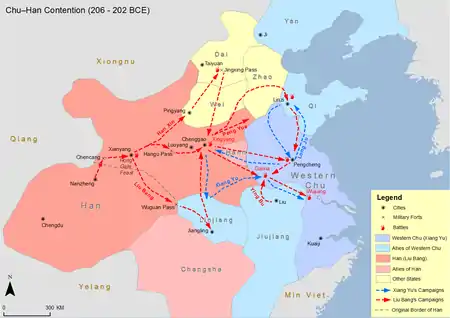 Chu-Han Contention (207 BC–202 BC)
Chu-Han Contention (207 BC–202 BC)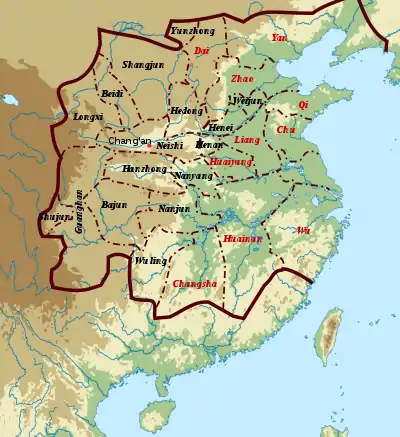 Han dynasty, 190 BC - kingdoms in red, commanderies in black
Han dynasty, 190 BC - kingdoms in red, commanderies in black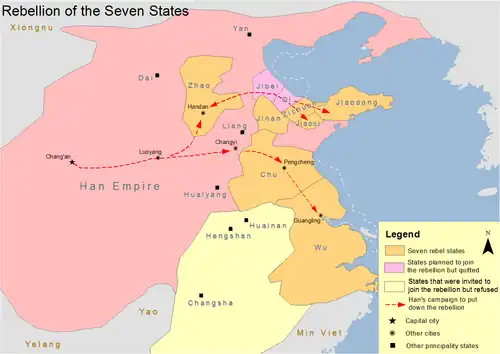 154 BC - Rebellion of the Seven States
154 BC - Rebellion of the Seven States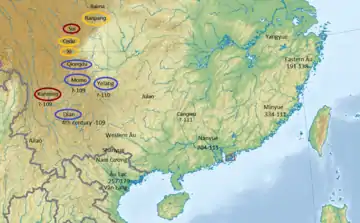 Southern tribes in ancient China - red means nomadic, yellow is semi-nomadic, and purple is sedentary.
Southern tribes in ancient China - red means nomadic, yellow is semi-nomadic, and purple is sedentary. Han campaigns
Han campaigns Korea 108 BC
Korea 108 BC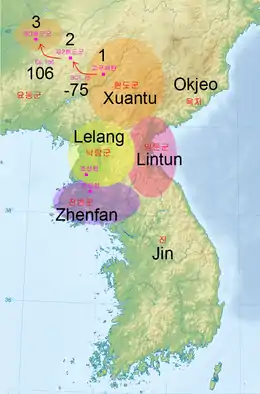 The Four Commanderies of Han, 107 BC
The Four Commanderies of Han, 107 BC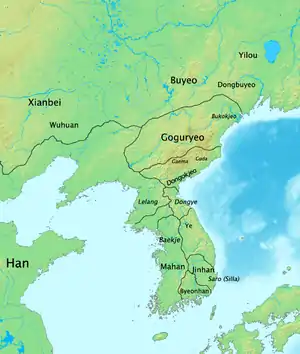 Korea in 1 AD
Korea in 1 AD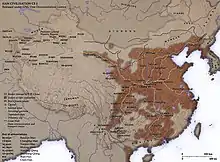 Extent of Han culture in 2 AD
Extent of Han culture in 2 AD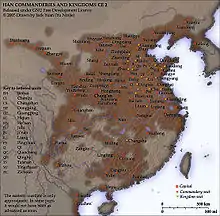 Han commanderies and kingdoms, 2 AD
Han commanderies and kingdoms, 2 AD Han dynasty population distribution in 2 AD
Han dynasty population distribution in 2 AD Major Yellow River course changes
Major Yellow River course changes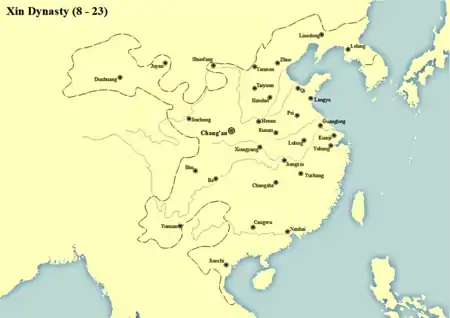
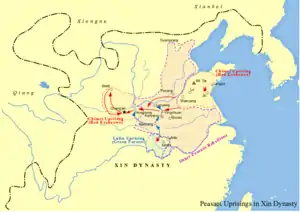 Uprisings during the Xin dynasty
Uprisings during the Xin dynasty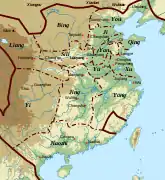 Han dynasty, 140 AD
Han dynasty, 140 AD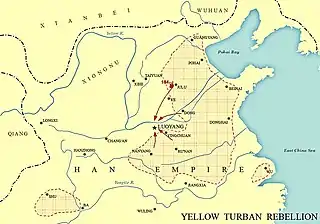
 Han provinces, 189 AD
Han provinces, 189 AD Korea 204 AD
Korea 204 AD
Citations
- ↑ Twitchett 2008, p. 119.
- ↑ Twitchett 2008, p. 122.
- 1 2 Twitchett 2008, p. 127.
- 1 2 3 4 5 6 7 8 9 Chang 2007, p. 143.
- 1 2 Twitchett 2008, p. 124.
- ↑ Twitchett 2008, p. 130.
- ↑ Twitchett 2008, p. 135.
- 1 2 3 Twitchett 2008, p. 136.
- ↑ Twitchett 2008, p. 137.
- ↑ David Buisseret (1998), Envisaging the City, U Chicago Press, p. 12, ISBN 978-0-226-07993-6
- 1 2 Twitchett 2008, p. 151.
- ↑ Twitchett 2008, p. 140.
- 1 2 Twitchett 2008, p. 152.
- ↑ Twitchett 2008, p. 138.
- ↑ Twitchett 2008, p. 141.
- ↑ Twitchett 2008, p. 144.
- 1 2 3 4 Twitchett 2008, p. 164.
- ↑ Twitchett 2008, p. 154.
- 1 2 3 4 Twitchett 2008, p. 450.
- 1 2 3 4 Twitchett 2008, p. 243.
- 1 2 3 4 5 6 7 8 9 10 Chang 2007, p. 164.
- 1 2 3 Twitchett 2008, p. 448.
- ↑ Twitchett 2008, p. 156.
- ↑ Twitchett 2008, p. 160.
- ↑ Twitchett 2008, p. 155.
- 1 2 3 4 Twitchett 2008, p. 234.
- 1 2 3 Twitchett 2008, p. 453.
- ↑ Twitchett 2008, p. 456.
- 1 2 3 4 5 Twitchett 2008, p. 235.
- 1 2 3 4 Twitchett 2008, p. 197.
- ↑ Twitchett 2008, p. 458.
- ↑ Twitchett 2008, p. 170.
- ↑ Twitchett 2008, p. 449.
- ↑ Twitchett 2008, p. 410.
- ↑ Twitchett 2008, p. 157.
- ↑ Barrett 2008, p. 34.
- 1 2 Twitchett 2008, p. 168.
- 1 2 Twitchett 2008, p. 169.
- ↑ Chang 2007, p. 219.
- ↑ Twitchett 2008, p. 178.
- ↑ Chang 2007, p. 220.
- ↑ Twitchett 2008, p. 179.
- ↑ Twitchett 2008, p. 180.
- 1 2 3 Twitchett 2008, p. 459.
- ↑ Twitchett 2008, p. 196.
- ↑ Twitchett 2008, p. 181.
- ↑ Chang 2007, p. 225.
- ↑ Shin 2014, p. 30.
- 1 2 Twitchett 2008, p. 184.
- 1 2 Twitchett 2008, p. 411.
- ↑ Chang 2007, p. 226.
- 1 2 Chang 2007, p. 227.
- ↑ Chang 2007, p. 228.
- ↑ Twitchett 2008, p. 200.
- ↑ Twitchett 2008, p. 202.
- 1 2 Twitchett 2008, p. 211.
- ↑ Twitchett 2008, p. 204.
- 1 2 Twitchett 2008, p. 206.
- 1 2 Xiong 2009, p. ccix.
- ↑ Twitchett 2008, p. 212.
- 1 2 Twitchett 2008, p. 210.
- ↑ Twitchett 2008, p. 221.
- ↑ Twitchett 2008, p. 215.
- ↑ Ebrey, Walthall & Palais 2005, p. 30.
- ↑ Twitchett 2008, p. 241.
- ↑ Twitchett 2008, p. 219.
- ↑ Twitchett 2008, p. 228.
- ↑ Twitchett 2008, p. 231.
- ↑ Twitchett 2008, p. 232.
- 1 2 3 Twitchett 2008, p. 238.
- ↑ Twitchett 2008, p. 239.
- ↑ Twitchett 2008, p. 245.
- 1 2 Twitchett 2008, p. 246.
- ↑ Twitchett 2008, p. 247.
- ↑ Twitchett 2008, p. 248.
- ↑ Twitchett 2008, p. 249.
- 1 2 Twitchett 2008, p. 250.
- 1 2 Twitchett 2008, p. 251.
- ↑ Loewe 2000, p. 525.
- 1 2 3 4 5 Twitchett 2008, p. 254.
- ↑ Crespigny 2017, p. 8.
- ↑ Needham, Joseph (1986), Science and Civilisation in China, Volume 4: Physics and Physical Technology, Part 2, Mechanical Engineering, Taipei: Cambridge University Press, p. 370, ISBN 0-521-05803-1
- 1 2 Twitchett 2008, p. 271.
- 1 2 3 4 5 6 7 Twitchett 2008, p. 460.
- ↑ Twitchett 2008, p. 279.
- ↑ Twitchett 2008, p. 269.
- 1 2 Twitchett 2008, p. 270.
- 1 2 Twitchett 2008, p. 272.
- 1 2 Twitchett 2008, p. 258.
- ↑ Twitchett 2008, p. 414.
- ↑ Twitchett 2008, p. 413.
- ↑ Twitchett 2008, p. 280.
- 1 2 3 Twitchett 2008, p. 421.
- ↑ Twitchett 2008, p. 282.
- ↑ Twitchett 2008, p. 415.
- ↑ Twitchett 2008, p. 268.
- 1 2 Twitchett 2008, p. 283.
- 1 2 Twitchett 2008, p. 285.
- ↑ Needham, Joseph (1959). Science and Civilization in China, Volume 3: Mathematics and the Sciences of the Heavens and the Earth. Cambridge: Cambridge University Press. pp. 626–635.
- ↑ Twitchett 2008, p. 310.
- ↑ Twitchett 2008, p. 513.
- 1 2 3 Twitchett 2008, p. 286.
- 1 2 3 4 Twitchett 2008, p. 311.
- ↑ Twitchett 2008, p. 287.
- ↑ Crespigny 2017, p. 369.
- 1 2 3 4 5 6 7 8 9 10 11 12 13 14 15 16 17 18 19 20 21 22 23 24 25 26 27 28 29 30 31 32 33 34 35 Crespigny 2007, p. xxxi.
- 1 2 3 4 5 Xiong 2009, p. lxxxvii.
- 1 2 3 Xiong 2009, p. lxxxviii.
Bibliography
- Barrett, Timothy Hugh (2008), The Woman Who Discovered Printing, Great Britain: Yale University Press, ISBN 978-0-300-12728-7 (alk. paper)
- Chang, Chun-shu (2007), The Rise of the Chinese Empire 1, The University of Michigan Press
- Crespigny, Rafe (2007), A Biographical Dictionary of Later Han to the Three Kingdoms (23-220 AD), Brill
- Crespigny, Rafe de (2017), Fire Over Luoyang: A History of the Later Han Dynasty, 23-220 AD, Brill
- Ebrey, Patricia Buckley; Walthall, Anne; Palais, James B. (2005), East Asia: A Cultural, Social, and Political History, Boston: Houghton Mifflin, ISBN 0-618-13384-4
- Knapp, Ronald G. (1980), China's Island Frontier: Studies in the Historical Geography of Taiwan, The University of Hawaii
- Loewe, Michael (2000). A Biographical Dictionary of the Qin, Former Han and Xin Periods (221 BC - AD 24). Leiden: Brill Publishers. ISBN 978-90-04-10364-1.
- Shin, Michael D. (2014), Korean History in Maps, Cambridge University Press
- Twitchett, Denis (2008), The Cambridge History of China 1, Cambridge University Press
- Xiong, Victor Cunrui (2009), Historical Dictionary of Medieval China, United States of America: Scarecrow Press, Inc., ISBN 0810860538
This article is issued from Wikipedia. The text is licensed under Creative Commons - Attribution - Sharealike. Additional terms may apply for the media files.
